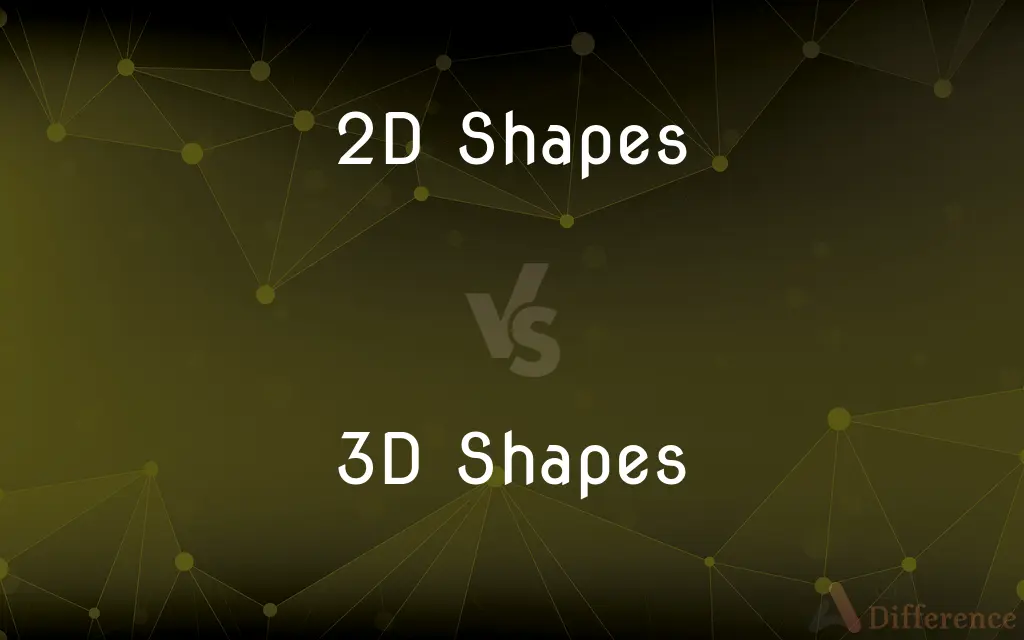2D Shapes vs. 3D Shapes — What's the Difference?
Edited by Tayyaba Rehman — By Fiza Rafique — Published on January 17, 2024
2D shapes have length and width, existing on a plane; 3D shapes add depth, existing in space.

Difference Between 2D Shapes and 3D Shapes
Table of Contents
ADVERTISEMENT
Key Differences
2D Shapes are flat figures with two dimensions – length and width – and are confined to a plane. They are defined by their boundary and do not have any thickness or volume. Examples of 2D shapes include squares, circles, and triangles, which are all measured in terms of their area, perimeter, or angles. They are often studied in geometry to understand the properties and relationships of figures on a flat surface.
3D Shapes, on the other hand, have three dimensions – length, width, and depth (or height). They occupy space and have volume. These shapes include cubes, spheres, and pyramids, and they are measured by their volume, surface area, and the angles between their faces. Unlike 2D shapes, 3D shapes can be picked up and held because they have a physical presence.
Every 2D Shape can be seen as a cross-section or a boundary outline of a 3D shape. For instance, a circle could be seen as a cross-section of a sphere, and a rectangle could be the face of a cube. However, while 2D shapes are involved in the study of geometry, 3D shapes extend into the study of three-dimensional space, often referred to as solid geometry.
While both 2D Shapes and 3D Shapes can be represented visually, 2D shapes are often used in diagrams, illustrations, and graphic designs due to their simplicity and ease of drawing. In contrast, 3D shapes are used in contexts where a more realistic representation is needed, such as in engineering, architecture, and computer graphics.
In the context of education, understanding 2D Shapes is usually a precursor to the study of 3D Shapes. The jump from 2D to 3D geometry involves conceptualizing an additional dimension, which can be a significant leap for many learners. Nonetheless, both 2D and 3D shapes are fundamental concepts in geometry and are vital for a comprehensive understanding of spatial relations.
ADVERTISEMENT
Comparison Chart
Dimensions
Two: length and width.
Three: length, width, and depth.
Volume
No volume.
Have volume.
Representation
Flat, can be drawn on paper.
Solid, can be modeled physically.
Measures
Area and perimeter.
Surface area and volume.
Real-world example
A drawing of a square.
A cube-shaped box.
Compare with Definitions
2D Shapes
Geometric figures that can be drawn on a flat surface.
The geometry test included questions about various 2D shapes.
3D Shapes
Geometric bodies that occupy space.
Kids enjoy playing with blocks because they are easy-to-handle 3D shapes.
2D Shapes
Outlines or figures without any depth.
The child's drawing consisted primarily of 2D shapes like triangles and circles.
3D Shapes
Models or figures with three dimensions.
The 3D printer can create complex 3D shapes from digital designs.
2D Shapes
Shapes that have area but no volume.
We covered the floor with tiles shaped in different 2D shapes.
3D Shapes
Solid figures with length, width, and depth.
The sculptor turned the clay into a variety of 3D shapes.
2D Shapes
Shapes that are measured in square units.
The math homework was to calculate the area of various 2D shapes.
3D Shapes
Shapes that have mass and can be physically held.
The warehouse was full of boxes in standard 3D shapes.
2D Shapes
Flat figures with only length and width.
She drew a series of colorful 2D shapes for her art project.
3D Shapes
Objects with volume measured in cubic units.
In science class, we learned to calculate the volume of different 3D shapes.
Common Curiosities
How are 3D shapes different from 2D shapes in real life?
3D shapes have depth and can be physically handled, unlike 2D shapes.
Can 2D shapes have depth?
No, 2D shapes do not have depth; they are flat.
Can 2D shapes become 3D shapes?
2D shapes can represent the faces of 3D shapes but cannot become 3D without adding depth.
Are circles 2D or 3D shapes?
Circles are 2D shapes.
Do 3D shapes always have more than one face?
Yes, 3D shapes have multiple faces.
Is it easier to calculate the area of a 2D shape or the volume of a 3D shape?
It depends on the complexity of the shape, but generally, 2D area calculations are considered simpler.
Can a single object have both 2D and 3D shape elements?
Yes, an object can have flat surfaces (2D elements) and solid parts (3D elements).
What is an example of a 3D shape?
A cube is an example of a 3D shape.
What is a 2D shape?
A 2D shape is a flat figure with two dimensions—length and width.
Do 2D shapes have angles?
Yes, 2D shapes can have angles.
What is a 3D shape?
A 3D shape is a solid figure with three dimensions—length, width, and depth.
How are 2D and 3D shapes taught in school?
They are taught progressively, with 2D shapes introduced before 3D shapes.
Are there any 2D shapes with curved sides?
Yes, circles and ellipses are 2D shapes with curved sides.
Are polygons 2D or 3D shapes?
Polygons are 2D shapes.
What’s the best way to visualize a 3D shape from a 2D shape?
Visualizing a 3D shape from a 2D shape often involves imagining the addition of depth or height to the 2D outline.
Share Your Discovery

Previous Comparison
SLIP vs. PPP
Next Comparison
Javascript vs. AJAXAuthor Spotlight
Written by
Fiza RafiqueFiza Rafique is a skilled content writer at AskDifference.com, where she meticulously refines and enhances written pieces. Drawing from her vast editorial expertise, Fiza ensures clarity, accuracy, and precision in every article. Passionate about language, she continually seeks to elevate the quality of content for readers worldwide.
Edited by
Tayyaba RehmanTayyaba Rehman is a distinguished writer, currently serving as a primary contributor to askdifference.com. As a researcher in semantics and etymology, Tayyaba's passion for the complexity of languages and their distinctions has found a perfect home on the platform. Tayyaba delves into the intricacies of language, distinguishing between commonly confused words and phrases, thereby providing clarity for readers worldwide.
















































